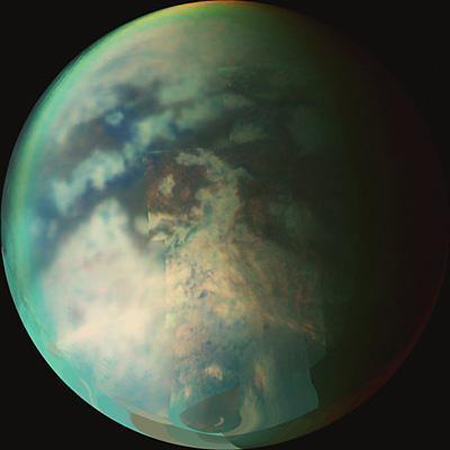Titan’s Orbit Proves It Has A Giant Ocean Underneath It’s Surface? Gnarly!

Scientific Astronomical Gurus have done some wizardy science crunching and come to a tenuous and probably incorrect but awesome conclusion: Saturn’s moon, Titan, has a giant ass ocean underneath its surface.
io9:
We know that Saturn’s moon Titan is home to everything from ice volcanoes to methane lakes to possibly even very simple forms of life. But its biggest secret is still hidden from sight: a giant subterranean ocean, possibly of water.
The evidence for this ocean comes from careful analysis of Titan’s orbit around Saturn. Its orbit is quite similar to that of the Moon around Earth – it keeps the same face towards Saturn and its axis tilts during rotation by about 0.3 degrees. From the orbital data that the Cassini probe has collected over the past seven years, we can then work out other figures, including the moon’s moment of inertia.
It’s on this point that things start to get weird. The moment of inertia value only makes sense if Titan is a solid body with a greater density near its surface than at its center. That completely contradicts everything we know about how planets and moons form, as they should all get denser the closer to the center one gets.
There are two alternative explanations for this result, one of which is particularly exciting. Titan’s apparent density problem can be solved quite neatly if there is a liquid ocean hidden beneath the moon’s icy shell. That’s the finding of Rose-Marie Baland and her colleagues at the Royal Observatory of Belgium. She explains:
“We assume the presence of a liquid water ocean beneath an ice shell and consider the gravitational and pressure torques arising between the different layers of the satellite.”
However, of course, this isn’t without its problems.
Baland and her team calculated the requirements of a water ocean beneath the moon’s icy exterior, but that seems unlikely considering how rich the moon is in methane and hydrocarbons. A subterranean methane ocean would make more sense and even help explain why Titan hasn’t long since exhausted its supply of the stuff, but a methane ocean would require a whole new set of calculations to make sure it’s still a viable explanation for the moon’s strange moment of intertia.
As with all astronomical findings, I am filing this under “probably not going to be true, but dope none the less.”



